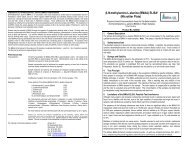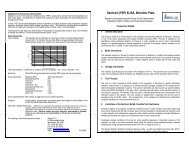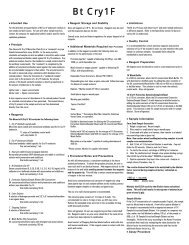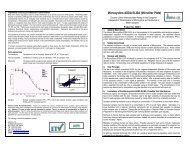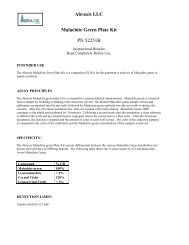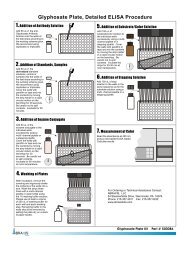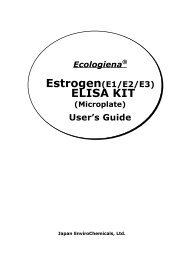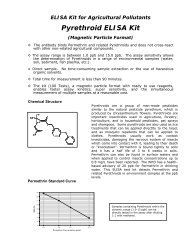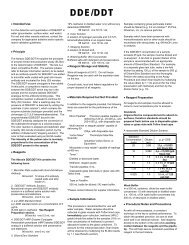Caffeine ELISA (Microtiter Plate) - Abraxis
Caffeine ELISA (Microtiter Plate) - Abraxis
Caffeine ELISA (Microtiter Plate) - Abraxis
- No tags were found...
You also want an ePaper? Increase the reach of your titles
YUMPU automatically turns print PDFs into web optimized ePapers that Google loves.
Importance of <strong>Caffeine</strong> DeterminationMost of the household water in the civilized world is treated before it is allowed to enter the environment but mishaps canoccur and untreated water can escape into streams, etc. It’s not always easy to identify when failure of WWTPs hasoccured or when surface waters are contaminated from septic systems, especially if it was an accident or occurred in aremote or unmanned location. One way around this is to analyze the surface waters regularly to detect changes in theamounts of marker compounds.Traditionally the quality of drinking and recreational water is ascertained using indicator bacteria. The traditional tests thatanalyze for the bacteria requires approximately 24 hours to complete and do not discriminate between human and animalsources. One potential solution is to use human wastewater chemicals such as caffeine, which would require shorteranalysis times and are human specific.One such compound is caffeine. <strong>Caffeine</strong> is perhaps the most widely consumed drug in the world because of itsextensive use in beverages (coffee, tea, soft drinks), food (chocolate, dairy products), and pharmaceuticals. It has beenproposed to be an effective marker for tracing surface water pollutants, which come from human wastewater due tosewage effluents from either wastewater treatment plants (WWTPs) or septic systems (1).Performance DataTest sensitivity: The detection limit for this assay is 0.150 ppb (ug/L)Test reproducibility: Coefficients of variation (CVs) for standards:
A. Materials Provided1. <strong>Microtiter</strong> plate coated with a second antibody (goat anti mouse).2. Standards (6): 0, 0.175, 0.50, 1.0, 2.5, 5.0 ng/mL.3. Antibody solution (mouse anti-<strong>Caffeine</strong>), 6 mL4. <strong>Caffeine</strong>-HRP, 6 mL5. Diluent/zero, 25 mL. Use to dilute samples with concentration above 5 ppb.6. Wash Solution 5X Concentrate, 100 mL7. Color Solution (TMB), 12 mL8. Stop Solution, 12 mLB. Test PreparationMicro-pipetting equipment and pipette tips for pipetting the standards and the samples are necessary. Werecommend using a multi-channel pipette or a stepping pipette for adding the antibody, enzyme conjugate,substrate solution, and the stop solution in order to equalize the incubations periods of the standardsolutions and the samples on the entire microtiter plate. Please only use the reagents and standards fromone package lot in one test, as they have been adjusted in combination. Read and understand theinstructions and precautions given in this insert before proceeding.1. Adjust the microtiter plate and the reagents to room temperature before use.2. Remove the number of microtiter plate strips required from the foil bag. The remaining strips are storedin the foil bag and zip-locked closed. Store the remaining kit in the refrigerator (4-8°C).3. The standard, control, antibody solution, enzyme conjugate, substrate and stop solutions are ready touse and do not require any further dilutions.4. The wash solution is a 5X concentrated solution and needs to be diluted with deionized water. In a 1Lcontainer dilute the 5X solution 1:5 (i.e. 100 mL of the 5X wash solution plus 400 mL of deionizedwater). The diluted solution is used to wash the microtiter wells.5. The stop solution has to be handled with care as it contains diluted H2SO4.C. Assay Procedure1. Add 50 µL of the standard solutions, control or samples into the wells of the test strips according to theworking scheme given. We recommend using duplicates or triplicates.2. Add 50 µL of antibody solution to the individual wells successively using a multi- channel pipette or astepping pipette. Cover the wells with parafilm or tape and mix the contents by moving the strip holderin a rapid circular motion on the bench top for about 30 seconds. Be careful not to spill contents.Incubate the strips for thirty (30) minutes at room temperature.3. Add 50 µL of the enzyme conjugate solution to the individual wells successively using a multi- channelpipette or a stepping pipette. Cover the wells with parafilm or tape and mix the contents by moving thestrip holder in a rapid circular motion on the bench top for about 30 seconds. Be careful not to spillcontents. Incubate the strips for forty five (45) minutes at room temperature.4. After incubation, remove the covering and vigorously shake the contents of the wells into a sink. Washthe strips four times using the 1X washing buffer solution. Please use at least a volume of 250 µL ofwashing buffer for each well and each washing step. Remaining buffer in the wells should be removedby patting the plate dry on a stack of paper towels.5. Add 100 µL of substrate/color solution to the wells using a multi- channel pipette or a stepping pipette.The strips are incubated for 20 minutes at room temperature. Protect the strips from sunlight.6. Add 100 µL of stop solution to the wells in the same sequence as for the substrate/color solution usinga multi- channel pipette or a stepping pipette.7. Read the absorbance at 450 nm using a microplate <strong>ELISA</strong> photometer within 15 minutes after stoppingthe reaction.D. EvaluationThe evaluation of the <strong>ELISA</strong> can be performed using commercial <strong>ELISA</strong> evaluation programs (4-parameters,Logit/Log or alternatively point to point). For a manual evaluation, calculate the mean absorbance value foreach of the standards. Calculate the %B/B0 for each standard by dividing the mean absorbance value foreach standard by the Zero Standard (Standard 0) mean absorbance. Construct a standard curve by plottingthe %B/B0 for each standard on a vertical linear (y) axis versus the corresponding <strong>Caffeine</strong> concentration onhorizontal logarithmic (x) axis on graph paper. %B/B0 for controls and samples will then yield levels in ppb of<strong>Caffeine</strong> by interpolation using the standard curve.The concentrations of the samples are determined using the constructed standard curve (do not use apreviously stored curve). Samples showing a lower concentration than 0.175 ppb of <strong>Caffeine</strong> areconsidered to be negative. Samples showing a higher concentration than standard 5 (5.0 ppb) must bediluted to obtain more accurate results.E. Additional Materials (not delivered with the test kit)1. Micro-pipettes with disposable plastic tips (50-250 µL)2. Multi-channel pipette (50-250 µL) or stepper pipette with plastic tips (50-250 µL)3. Reagent reservoir for multichannel pipettes4. <strong>Microtiter</strong> plate washer (optional)5. <strong>Microtiter</strong> plate reader (wave length 450 nm)6. Shaker for microtiter plates (optional)F. Working SchemeThe microtiter plate consists of 12 strips of 8, which can be used individually. The standards must berun with each test. Never use the values of standards which have been determined in a test performedpreviously.Std 0-Std 5: StandardsSam1, Sam2, Sam3, etc.: SamplesRecoveryFour (3) groundwater samples, were spikedwith various levels of <strong>Caffeine</strong> and thenassayed using the <strong>Abraxis</strong> <strong>Caffeine</strong> Assay.The following results were obtained:Amount of ---------------- Recovery -----------<strong>Caffeine</strong> Mean S.D.RecoveryAdded ____________________________(ppb) (ppb) (ppb) (%)0.50 0.536 0.094 1071.00 1.002 0.071 1004.00 3.676 0.212 92PrecisionThe following results were obtained:Control ____________________________1 2 3Replicates 3 3 3Days 3 3 3n 9 9 9Mean (ppb) 0.516 0.996 3.876% CV (within assay)7.9 5.5 3.6% CV (between assay) 12.8 10.2____________________________6.8SensitivityThe <strong>Abraxis</strong> <strong>Caffeine</strong> <strong>ELISA</strong> has an estimated minimum detectable concentration, based on 90% B/Boof 0.150 ppb.G. References(1) Buerge, Ignaz, J. Poigner, Thomas, Markus D., and Buser, Hans-Rudolph. (2003). <strong>Caffeine</strong>, an AntropogenicMarker for Wastewater Contamination of Surface Waters. Environ. Sci. Technol. 37, 691-700.




